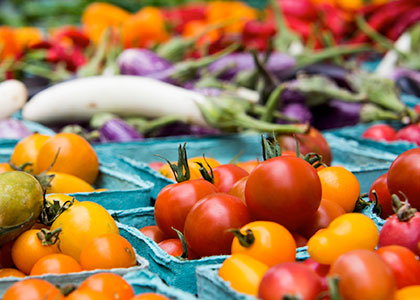
6 Surprising Facts about Eating Locally
By Stacy Kennedy, MPH, RD, CSO, LDN; Reboot Nutritionist
With summer kicking off, more farmer’s markets, CSAs and other local food outlets are providing fresh, seasonal produce at your fingertips. While relying on a chain supermarket to buy all your groceries can be convenient, you are likely missing out on the benefits of buying local foods.
Buying local has become a trendy nutrition craze, like superfoods and cleanses, with local food sales totaling about $6.1 billion in 2012. You’ve heard the buzz about why local foods are healthiest, like boasting more nutrients. But did you know about these six surprising facts?
1. The local foods boom was hot in the early-mid 2000s.
Well, okay that’s not 100% accurate. Back in 1900, 40% of Americans lived on farms, so you could say the “local” craze was at its peak at the turn of the last century. Compare this to a meager 1% a century later, in 2000. Farmer’s Markets doubled in number between 1998 to 2009, and the number of farms with direct to consumer sales increased by 17% with overall sales increasing by 32% between 2002 and 2007.
2. Pigeon Peas, African Eggplant and Tatsoi…Can you name that veggie?!
Local markets promote variety and diversity in your diet. While large grocery stores often provide the same produce items all year round, despite seasonal changes, local farmers markets offer a refreshing variety of fruits and vegetables according to what’s available and in season. By eating local foods as they change with the seasons, you’ll not only have the opportunity to explore lesser-known fruits and vegetables, like gooseberries, garlic scapes, or fiddleheads, but you’ll also end up consuming a wider range of nutrients, native to these plants. If you’re lucky, farmers may even offer you a free sample of their unique product!
3. The ancient art of storytelling meets your produce basket.
Farmers are knowledgeable and open to sharing the story behind their food. Local farmers typically have a greater understanding and passion about the products they are selling and take more time to get to know their customers. They can explain how the food was grown and share the practices they use to raise and harvest crops, allowing you to understand and appreciate the story behind your food. Even more, farmers may have some insider tips on how to best prepare their products.
4. Local markets promote a safe food supply.
Ever wonder why you don’t see local farms listed in the ever present FDA Foods Recall Alerts? Compared to the farmers growing the produce sold at supermarkets who are somewhat anonymous to customers, farmers at local markets are more closely connected to customers. This transparency at local markets ensures that farmers take their responsibility of providing safe food to customers seriously. Food safety issues are also less likely to be a problem when purchasing local foods due to the shorter travel time and distance, meaning less time and opportunity for food to become contaminated.
5. Put your money where your mouth is.
Buying local food supports local family farms. Did you know that today’s farmers receive less than 10 cents of every retail food dollar? With many of the risks that come with farming (i.e., unfavorable weather or pests), this wholesale price is often not enough to keep local family farms in business. Selling directly to consumers at local farmers markets cuts out the middlemen and the burden of marketing, allowing farmers to receive better prices for their crops, often making the products cheaper for the consumer too. With less than 1% of Americans claiming farming as their primary occupation, supporting local farmers can help them gain financial security to sustain their farm and continue to provide healthy, seasonable foods to your community.
6. Going green gets serious.
Caring about the environment goes beyond posting signs around town about recycling and passing laws against plastic bags at checkout. Choosing local food can be an important step to sustain local farmland, preserve environmental resources, and invest in future generations’ health and well-being. Supporting local farmers ensures that community farmland is adequately maintained, preventing the land from being sold for development. Preserving farmland provides the community with access to healthy food, as well as a habitat for many species of wildlife. Local farms also benefit the environment because little fuel and energy are needed from the time of harvest to distribution, with less packaging and transportation. Local farms grow a larger variety of crops, sustaining diversity. By protecting genetic diversity, local farming provides greater availability to genes that may be necessary in the future to adapt to changes in climate and new pests.
Looking for ways to incorporate more local food in your diet? Check out or the USDA’s Local Food Directories to find farmers markets, CSAs, food hubs, or on-farm markets near your community.